Overview
The article delineates ten significant benefits of utilizing 2.0ml microcentrifuge tubes, underscoring their crucial role in boosting laboratory efficiency across diverse scientific domains. These advantages encompass:
- A robust design that ensures secure sealing
- Compatibility with automation systems
- Low-binding characteristics that effectively minimize sample loss
Collectively, these features contribute to enhanced accuracy, reliability, and overall operational efficiency within laboratory environments.
Introduction
In the realm of scientific research, the tools and materials employed can profoundly influence the outcomes of experiments and analyses. Among these critical components, 2.0ml microcentrifuge tubes emerge as essential for their versatility and reliability across a spectrum of applications, ranging from molecular biology to clinical diagnostics. These tubes serve not merely as containers; they are meticulously engineered to enhance sample integrity, streamline workflows, and support innovative research practices.
As laboratories increasingly prioritize precision and efficiency, comprehending the multifaceted benefits of these microcentrifuge tubes becomes paramount for the advancement of scientific endeavors. This article explores the extensive applications and advantages of 2.0ml microcentrifuge tubes, underscoring their indispensable role in contemporary laboratory environments.
JM Science 2.0ml Microcentrifuge Tubes: Reliable Quality for Precise Applications
JM Science's 2.0ml microcentrifuge tubes are crafted from high-quality polypropylene, ensuring exceptional durability and resistance to breakage during centrifugation. The design features a smooth interior that minimizes protein sticking, a critical factor for preserving specimen integrity. Moreover, the containers boast excellent transparency, providing outstanding visibility of specimens, which facilitates straightforward observation and examination. Such attributes underscore the importance of utilizing in laboratory environments.
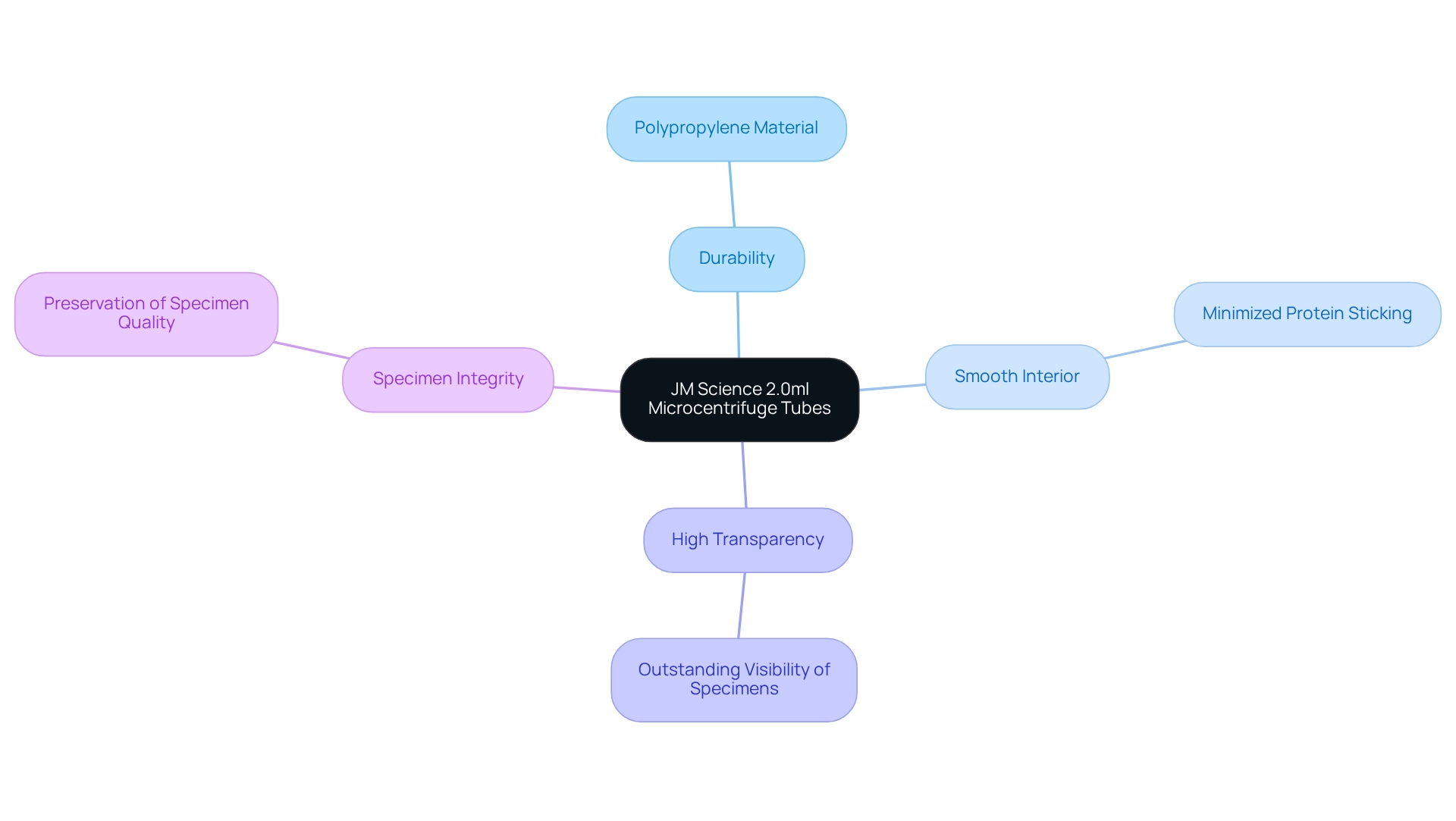
Sample Storage: Utilizing 2.0ml Microcentrifuge Tubes for Efficient Sample Preservation
The effective storage of biological samples relies on the use of . Their secure sealing capabilities play a critical role in preventing contamination and evaporation, ensuring sample integrity. Designed to withstand a broad spectrum of temperatures, these containers are suitable for both short-term and long-term storage needs. The quality of these products is further enhanced through JM Science Inc.'s strong partnerships with leading manufacturers, guaranteeing that they meet the highest standards of innovation and reliability in research environments.
To maximize workflow efficiency, proper labeling and organization of these containers are paramount. Implementing a systematic labeling strategy facilitates quick retrieval and analysis of samples, significantly reducing downtime and boosting overall productivity within the facility. By adopting these best practices, laboratories can fully leverage the advanced capabilities of 2.0ml microcentrifuge tubes, ultimately enhancing their operational efficiency.

Molecular Biology: Enhancing DNA and RNA Extraction with 2.0ml Microcentrifuge Tubes
In molecular biology, 2.0ml microcentrifuge tubes are essential for DNA and RNA extraction protocols. Their specialized design facilitates efficient mixing and centrifugation, critical for effectively separating nucleic acids from cellular debris. The low-binding characteristics of these cylinders significantly minimize material loss, resulting in increased yields of purified nucleic acids vital for subsequent applications such as PCR and sequencing.
Recent studies, including data identified by Qiita (study identifier: 12201), demonstrate that utilizing can reduce sample loss rates, thereby enhancing the overall efficiency of nucleic acid extraction processes. Furthermore, protocols employing these containers have been shown to improve the quality of extracted RNA, making them indispensable tools in molecular biology research.
For instance, features user-friendly protocols that promote ease of use, ensuring facilities can seamlessly integrate the kit into their workflows. Practical applications indicate that laboratories utilizing these devices achieve enhanced workflow efficiency and reliability in their experimental results.
As emphasized by New England Biolabs (NEB), conducting ethical science involves minimizing material loss during nucleic acid extraction, aligning perfectly with the functions of low-binding containers. Overall, integrating these cylinders into laboratory practices not only boosts extraction efficiency but also upholds the ethical standards of scientific research.

Clinical Diagnostics: Streamlining Sample Analysis with 2.0ml Microcentrifuge Tubes
In clinical diagnostics, the use of 2.0ml microcentrifuge tubes is essential for the preparation and analysis of biological materials, including blood and urine. Their secure closure design effectively prevents contamination and evaporation, thereby ensuring the integrity of the material throughout processing. This aspect is particularly critical, as contamination can significantly skew diagnostic results; studies indicate that improper handling can lead to a 30% increase in erroneous test outcomes.
Moreover, these containers are engineered for compatibility with automated systems, which is vital for enhancing throughput and efficiency within diagnostic facilities. Automation statistics reveal that facilities utilizing small centrifuge containers can achieve up to a 50% increase in processing speed, facilitating quicker turnaround times for essential diagnostics.
The strategic use of 2.0ml microcentrifuge tubes not only streamlines sample analysis but also meets the growing demand for advanced research equipment in response to the escalating global burden of chronic diseases. As Laura Wood, Senior Press Manager, notes, "As the global burden of chronic diseases keeps increasing, healthcare providers must enhance their diagnostic capabilities, thus increasing the demand for sophisticated testing equipment." This statement underscores the significance of high-quality small centrifuge containers in achieving precise analysis.
Furthermore, the market for these containers is predominantly led by North America, influenced by the concentration of research laboratories and healthcare facilities, further highlighting the importance of these items in clinical diagnostics. The utilization of is a pivotal factor in preventing contamination and ensuring reliable test outcomes.
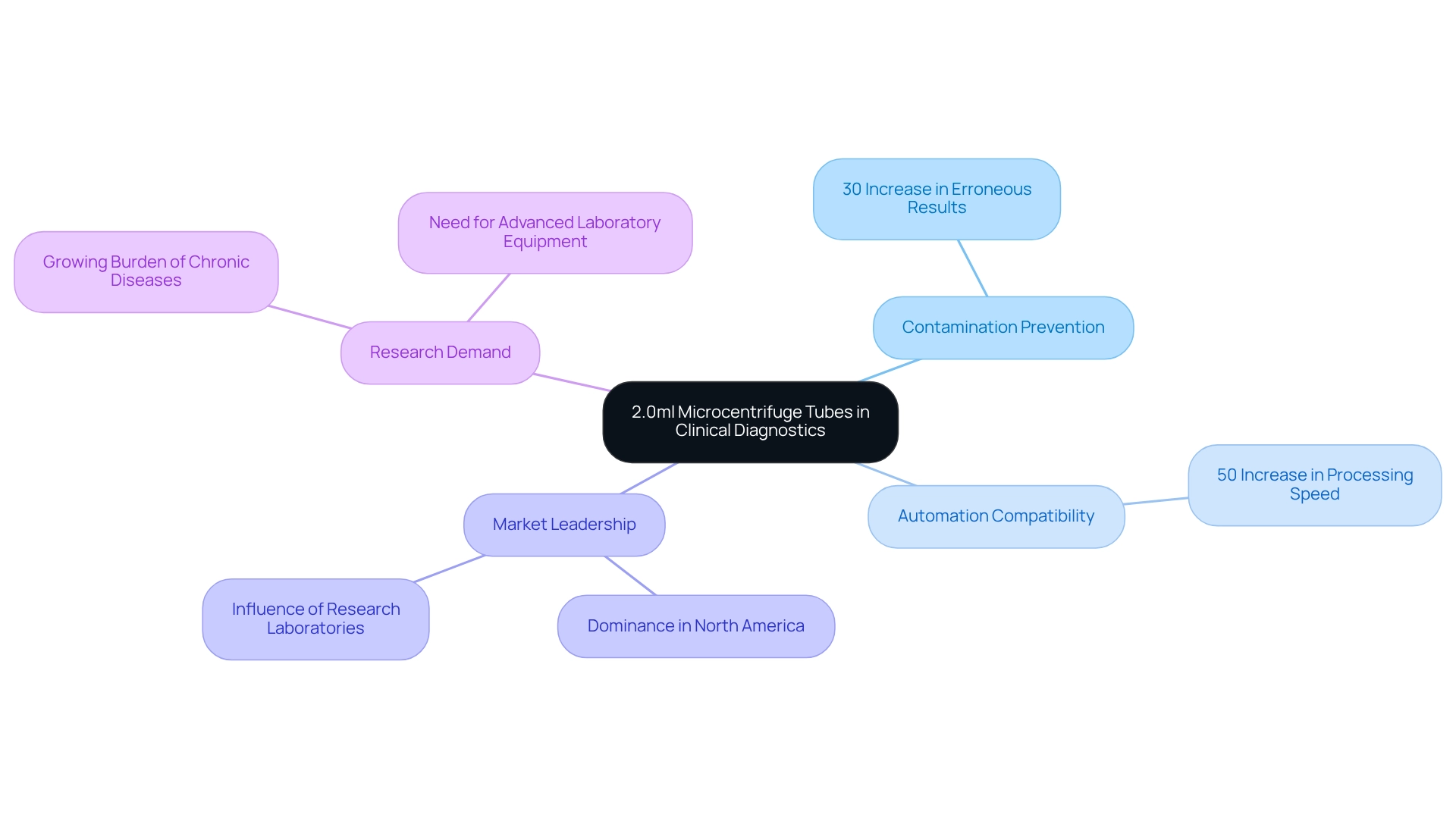
Pharmaceutical Research: Supporting Drug Development with 2.0ml Microcentrifuge Tubes
The use of 2.0ml microcentrifuge tubes is indispensable in pharmaceutical research, particularly in the formulation and testing of new medications. These containers play a vital role in preparation, facilitating the dissolution and blending of substances critical for precise analysis. Their robust design allows 2.0ml microcentrifuge tubes to withstand significant centrifugal forces, ensuring effective sample processing, which is essential for obtaining reliable outcomes in drug efficacy research.
In drug development, 2.0ml microcentrifuge tubes support various sample preparation methods, including the separation of cellular constituents and the concentration of analytes. Their versatility renders them essential in laboratories, where precision and reliability are paramount. Moreover, the integration of advanced analytical techniques, such as those offered by AQV-300 Volumetric and AQ-300 Coulometric Karl Fischer Titrators, significantly enhances the accuracy of moisture content analysis in pharmaceuticals, ensuring adherence to the Japanese Pharmacopoeia. This collaboration between small centrifuge containers and titration techniques underscores their combined importance in drug testing and formulation processes.
Beyond the realm of pharmaceutical research, small centrifuge containers find applications in industrial sectors, forensic analysis, and various other fields, highlighting their extensive versatility. As the pharmaceutical industry continues to evolve, the importance of high-quality 2.0ml microcentrifuge tubes in enhancing research outcomes cannot be overstated, establishing these tubes as a crucial tool in the quest for innovative drug solutions.

Environmental Testing: Collecting and Analyzing Samples with 2.0ml Microcentrifuge Tubes
In environmental testing, 2.0ml microcentrifuge tubes play a crucial role in the collection and examination of specimens from various sources, including soil and water. Their robust polypropylene design guarantees secure transport and storage, while compatibility with a wide range of analytical methods ensures accurate results. These versatile cylinders are essential for both qualitative and quantitative analyses, making them indispensable tools in environmental laboratories.
For instance, when utilizing products such as , specifically designed to identify E. coli and coliforms in water specimens, it is vital for reliable outcomes that samples are collected in 2.0ml microcentrifuge tubes. Environmental researchers emphasize that employing appropriate methods for gathering and analyzing materials using 2.0ml microcentrifuge tubes significantly enhances testing precision.
As one specialist noted, 'The utilization of 2.0ml microcentrifuge tubes allows for improved maintenance of sample integrity, which is crucial for precise environmental evaluations.' This underscores the importance of these instruments in effectively monitoring water quality and safety, particularly given the statistical relevance of HiCrome Chromogenic Coliform Agar in accurately detecting harmful bacteria.
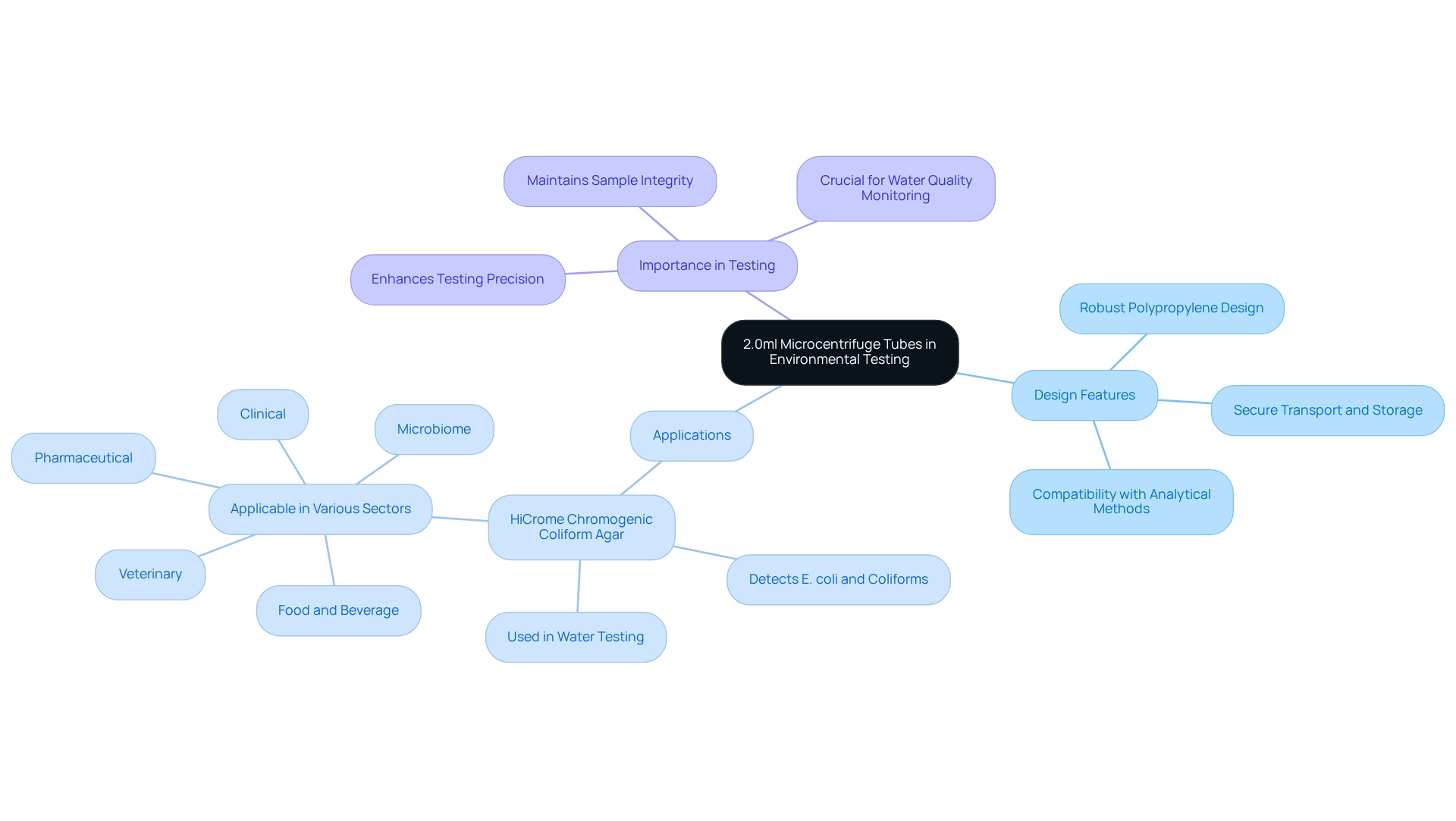
Educational Laboratories: Facilitating Experiments with 2.0ml Microcentrifuge Tubes
In educational settings, 2.0ml microcentrifuge tubes serve as essential tools for student experiments involving:
- DNA extraction
- Protein analysis
- Various practical activities
The ease of use and secure sealing of 2.0ml microcentrifuge tubes not only enhance the learning experience but also make these tubes ideal for teaching fundamental laboratory techniques. By engaging with these instruments, students gain invaluable hands-on experience that is crucial for their understanding of scientific concepts. This practical exposure fosters a deeper comprehension of laboratory practices, ultimately preparing them for future scientific endeavors. The integration of such high-quality scientific instruments into the curriculum is vital for cultivating the next generation of skilled professionals.

Biotechnology Applications: Leveraging 2.0ml Microcentrifuge Tubes for Innovative Research
In biotechnology, 2.0ml microcentrifuge tubes are indispensable across various applications, including cloning, gene expression studies, and protein purification. Their specialized design promotes efficient mixing and centrifugation, essential for isolating specific biomolecules with precision. For instance, in gene expression research, these containers enable scientists to effectively isolate RNA and DNA, ensuring high-quality samples for subsequent applications.
Furthermore, the compatibility of 2.0ml microcentrifuge tubes with automation systems significantly enhances their utility in high-throughput research environments. This feature streamlines laboratory workflows, boosting productivity while minimizing the risk of contamination. Consequently, these vessels are vital in contemporary biotechnology research, where efficiency and reliability are paramount.
Regulatory compliance is critical in the pharmaceutical sector, necessitating the use of certified centrifuge containers. Leading companies in the centrifuge vessel market, such as Eppendorf and Thermo Fisher, are committed to continuous innovation, enhancing vessel design and functionality. This commitment ensures that researchers have access to top-quality products that meet stringent criteria. The accuracy of experimental results can directly influence research outcomes and patient safety, making the quality of these vessels essential.
Overall, the applications of 2.0ml microcentrifuge tubes in biotechnology not only elevate research capabilities but also contribute to advancements in fields like genomics and proteomics. As aptly stated, "From the lab to the field, from cells to societies, biotechnology carves the path from scientific insight to revolutionary applications," highlighting the importance of these tools within the scientific community.
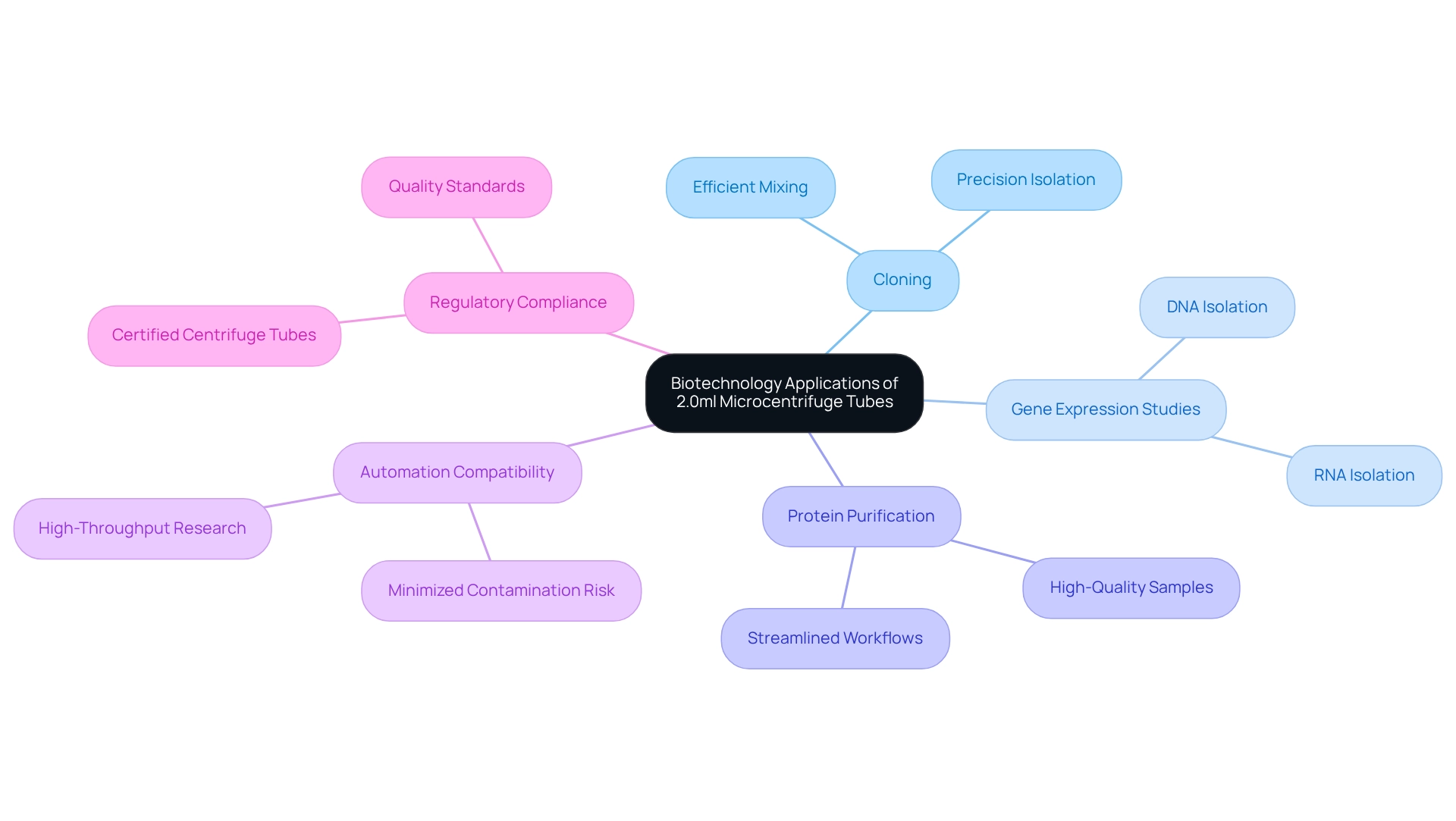
Quality Control: Ensuring Sample Integrity with 2.0ml Microcentrifuge Tubes
Quality assurance is paramount in scientific settings, especially when utilizing 2.0ml microcentrifuge tubes, which play a critical role in preserving specimen integrity. Designed to significantly reduce contamination and evaporation, these containers ensure that specimens remain stable throughout the testing process. Various options, including sterile, RNase-free, and DNase-free variants, cater to specific research needs, thereby enhancing reliability in sensitive analyses.
Routine quality assessments and adherence to best practices in handling containers are vital for optimizing results. For example, a study on protein digestion techniques demonstrated that low binding microtubes can enhance digestion efficiency, resulting in improved recovery rates and superior peptide identification. This underscores the importance of selecting the right material for 2.0ml microcentrifuge tubes to maintain specimen integrity.
Experts emphasize that continuous advancements in centrifuge handling are driven by the need for improved performance and automation, all while ensuring stringent oversight of specimen integrity with 2.0ml microcentrifuge tubes. By implementing comprehensive quality control measures, laboratories can substantially decrease contamination rates, thereby increasing the accuracy of their findings.
Notably, statistics reveal that the average protein length in specimens processed with remains remarkably consistent at 471.004±11.648, further validating their effectiveness in preserving specimen integrity during testing. Additionally, research indicates that the average protein length was significantly higher in L_S compared to L_AC and N_V, highlighting the performance variations among different containers and their impact on sample integrity.
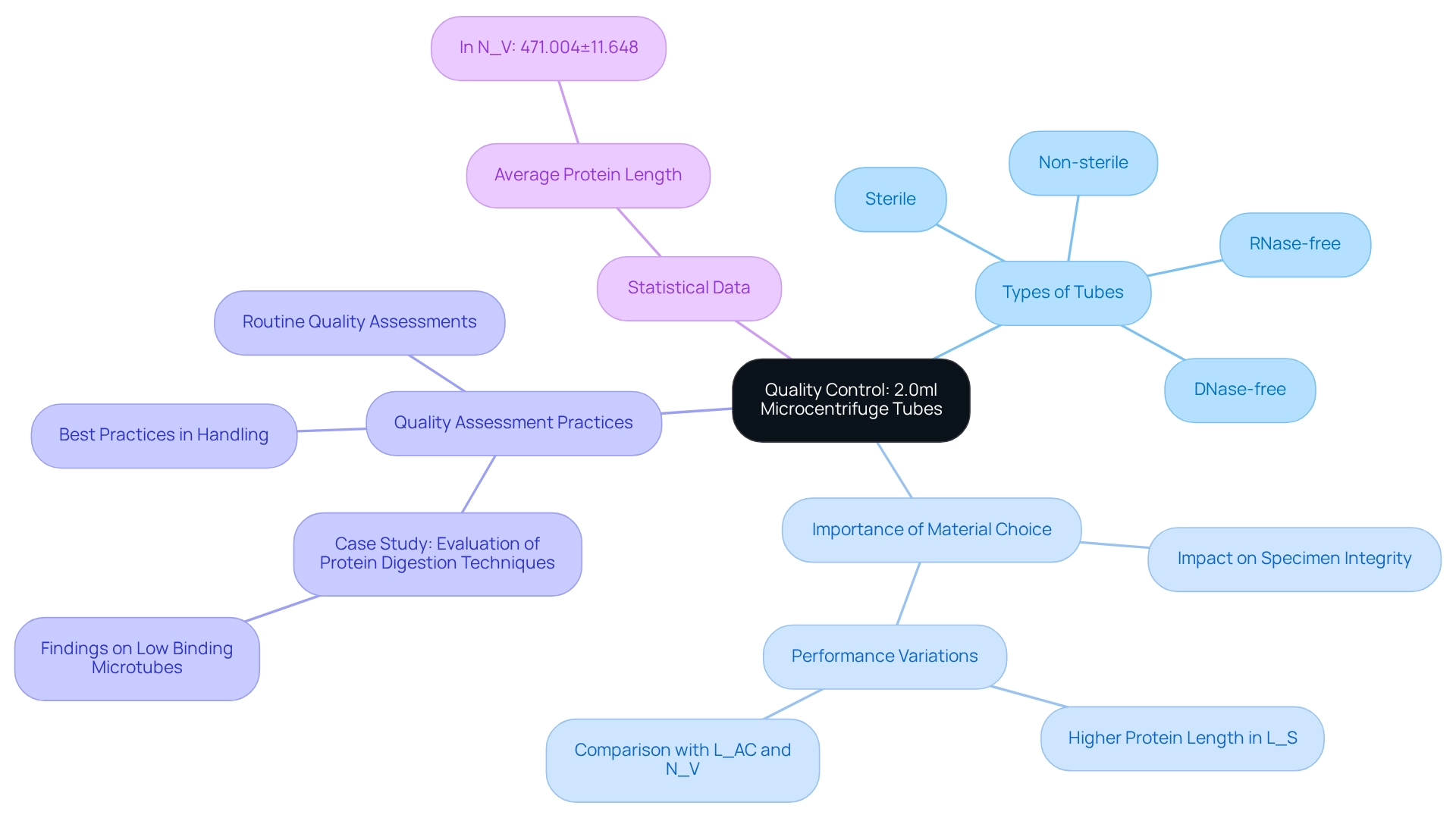
Overall Benefits: Why 2.0ml Microcentrifuge Tubes are Essential in Every Lab
are indispensable in contemporary laboratories, recognized for their versatility, dependability, and effectiveness. These containers are utilized across various applications, including molecular biology, clinical diagnostics, and environmental testing. Their robust construction and secure sealing capabilities ensure compatibility with diverse analytical techniques, which is essential for achieving accurate and reproducible results.
The adaptability of these containers is underscored by their extensive use in numerous scientific fields, from academic research to industrial applications and forensic studies. As laboratories increasingly prioritize efficiency and precision, the demand for high-quality centrifuge containers, such as 2.0ml microcentrifuge tubes, is on the rise, highlighting their critical role in advancing scientific research and innovation. Notably, established companies in the market, such as Eppendorf and Thermo Fisher, contribute significantly to this competitive landscape, driving innovation and quality in the production of small centrifuge containers.
Furthermore, industry insights indicate that using 2.0ml microcentrifuge tubes for each experiment is a best practice, enhancing the reliability of experimental outcomes. Statistics support this recommendation, emphasizing the importance of optimal results. This commitment to quality is echoed by lab managers, including Emily Carter, who states, 'By adhering to best practices for managing and utilizing 2.0ml microcentrifuge tubes, researchers can ensure the dependability and accuracy of their experimental outcomes.' As the market for these essential tools continues to expand, 2.0ml microcentrifuge tubes will remain a cornerstone of effective laboratory operations, highlighting their significance in achieving research success.
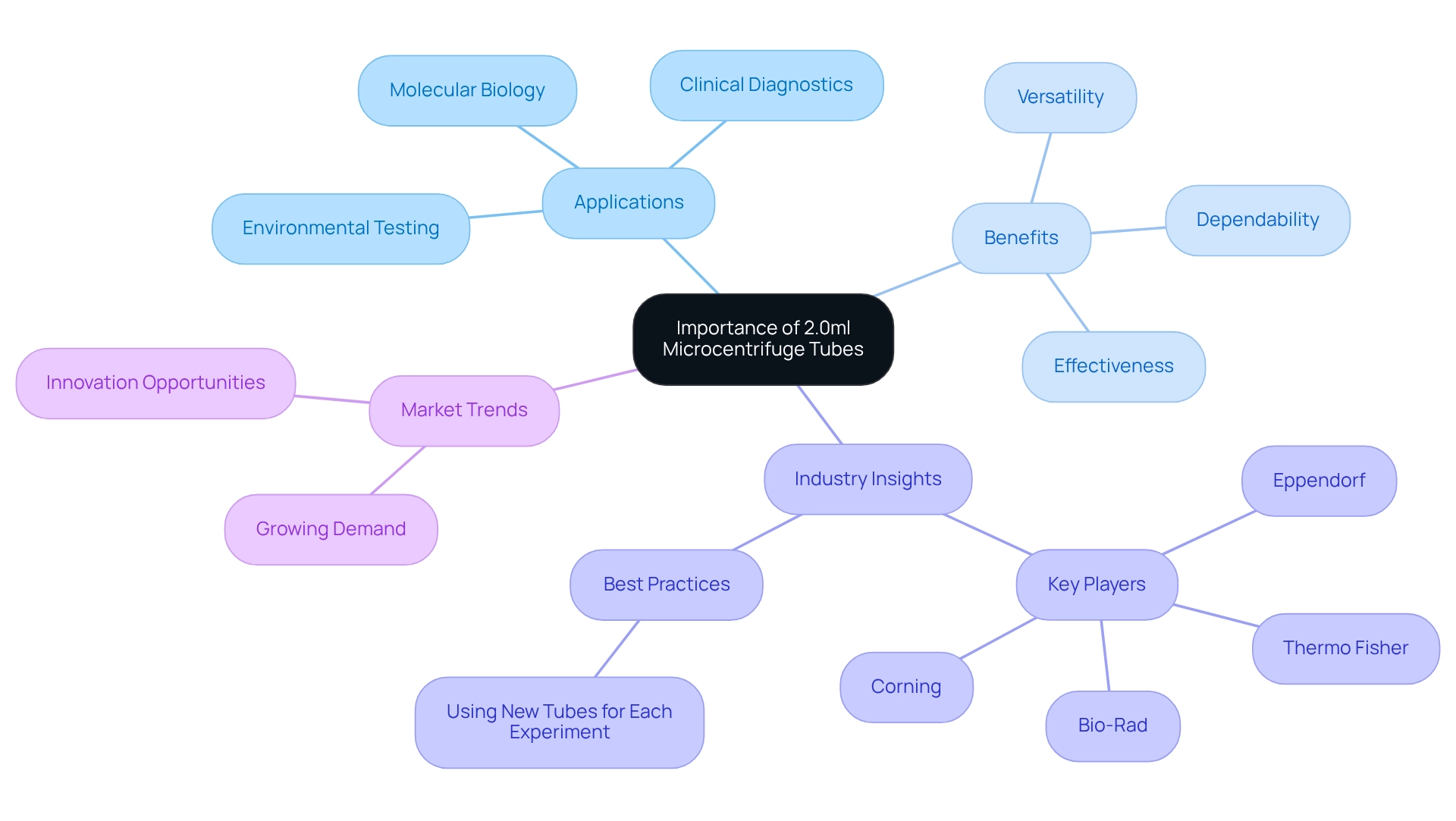
Conclusion
2.0ml microcentrifuge tubes are essential assets in contemporary laboratory environments, delivering a combination of versatility, reliability, and efficiency across numerous scientific fields. Their design enhances sample integrity, optimizes workflows, and supports innovative research methodologies, making them indispensable from molecular biology to clinical diagnostics and environmental testing. The robust construction and secure sealing capabilities of these tubes ensure compatibility with a wide array of analytical techniques, which is crucial for achieving accurate and reproducible results.
The diverse applications of these microcentrifuge tubes underscore their vital role in propelling scientific research and innovation forward. As laboratories increasingly prioritize precision and efficiency, the demand for high-quality microcentrifuge tubes continues to escalate, fueled by leading manufacturers dedicated to excellence in design and functionality. The practice of utilizing new tubes for each experiment further highlights the necessity of preserving sample integrity, thus enhancing the reliability of experimental outcomes.
Ultimately, the importance of 2.0ml microcentrifuge tubes transcends their functional characteristics; they represent a commitment to quality and best practices in laboratory operations. As scientific endeavors progress and research complexities intensify, these tubes will undoubtedly remain a cornerstone of effective laboratory practices, reinforcing their essential contribution to achieving research success and fostering advancements across various fields.




